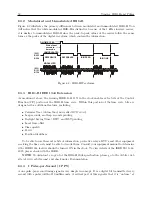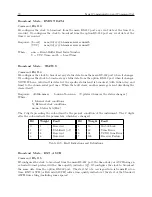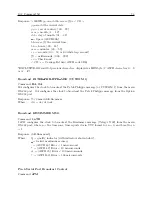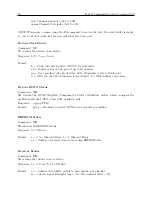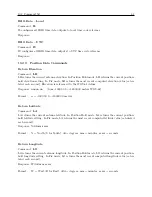
66
Serial Communication and Command Set
Using Ordinals and Conditionals
An ordinal returns an ASCII character or characters (e.g. 1, 2, 3,...., good, bad, etc.)
for a
requested value (e.g. clock accuracy). A conditional returns an ASCII character or characters (e.g.
0, 1, locked, unlocked, etc.) based on a true/false request (e.g. Is there a Fault?). Illustrated below
are several examples of using ordinals and conditionals when constructing a custom string. You can
even construct standard strings to check your work. All the ordinal/conditional examples below
use the ASCII Standard broadcast string.
Ordinal 01.
This ordinal consists of 13 different accuracy values as listed in Table 10.2. Notice
the ordinals (0, 1, 2,...,B,F) are all represented in this example. All need not be used as shown in
the second example. This example more closely follows the 1093A/B/C accuracy, not signaling a
change until reaching 1 microsecond.
@@A/T01/d:/h:/m:/s/
{
01?0/:1/:2/:3/:4/:5/:6/:7/:8/:9/:A/:B/:F/
}
/r
@@A/T01/d:/h:/m:/s/
{
01?0/:0/:0/:0/:4/:5/:6/:7/:8/:9/;out of lock/
}
/r
Note that the accuracy values (e.g. 0, 1, 2,...,F) can be replaced with textual values. For
example, note that the value ”out of lock” in the second example replaced everything after ”9” in
the first example.
Ordinal 02.
This ordinal consists of 5 different accuracy values as listed in Table 10.3.
@@A/T01/d:/h:/m:/s/
{
02? /:./:
∗
/:#/:?/
}
/r
Ordinal 03.
This ordinal consists of three different time zone values: DST active (i.e. Daylight
Saving Time), DST inactive (i.e. Standard Time) and UTC time.
@@A/T01/d:/h:/m:/s/
{
03? DST Active/: DST Inactive/: UTC/
}
/r
Conditional 03.
In this condition the clock is queried for a locked condition. It answers true with
a space if locked and false with a question mark if unlocked.
@@A/T01/d:/h:/m:/s/[03? /:?/]/r
10.2.2
String Setup Examples and Tutorial
In this section, you will find a number of examples of constructing a custom broadcast string that
produces one of the standard broadcasts. By building up a custom string that produces a standard
broadcast, you to compare the output your custom string produces with that of the standard
broadcast. If the outputs agree, then your custom string must be correct. This should give you
some confidence in constructing your own broadcast string.
In each broadcast example that follows the first line will give the broadcast name, the second
line will give the desired broadcast output and the third line shows the custom input string code.
At the end of each example, you will find some string constructions notes to help you understand
how to use the custom string commands in Table 10.1. This includes the use of ordinals and
conditionals.
Содержание 1092A
Страница 4: ...iv ...
Страница 18: ...xviii LIST OF TABLES ...
Страница 129: ...C 10 Option 20A Four Fiber Optic Outputs 111 Figure C 7 Option 20A Jumper Locations ...
Страница 131: ...C 11 Option 27 8 Channel High Drive 113 Figure C 8 Option 27 Jumper Locations ...
Страница 148: ...130 Options List Figure C 10 Option 29 Connector Signal Locations ...

